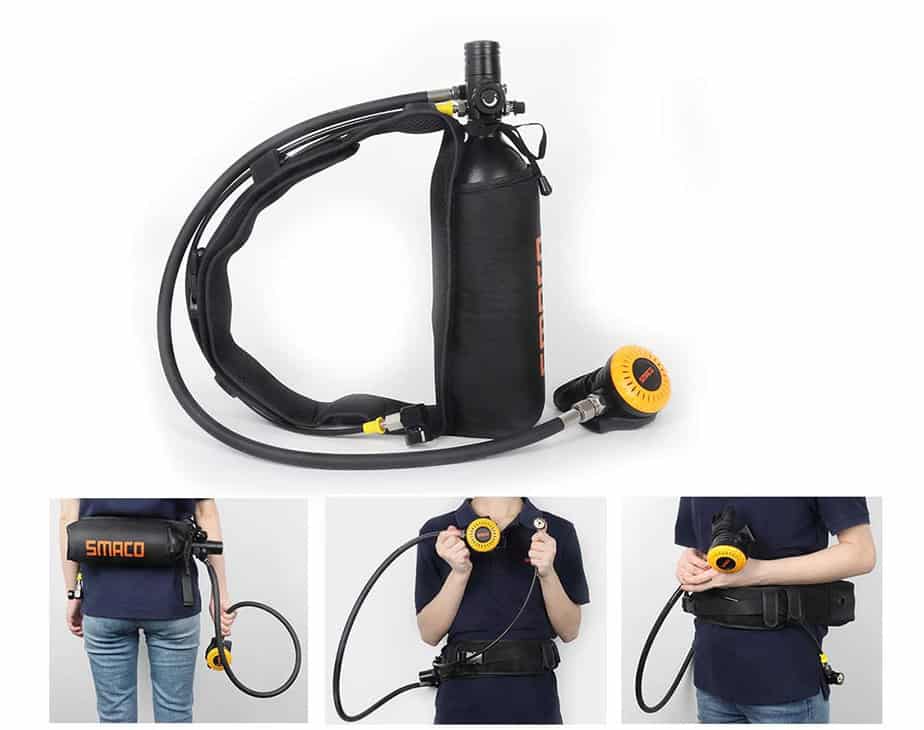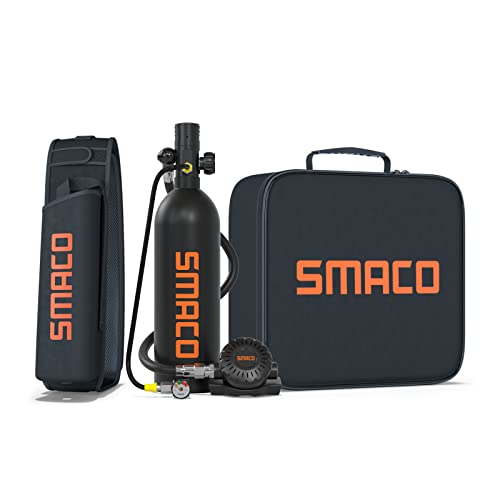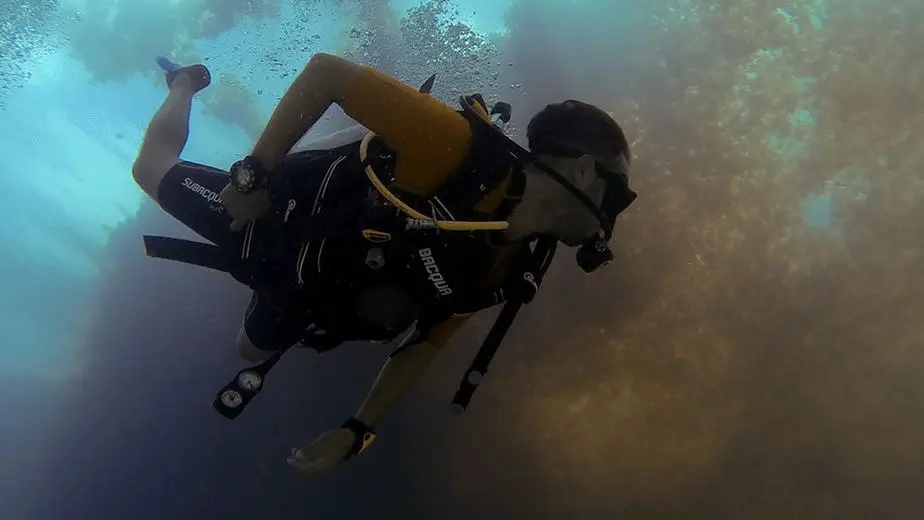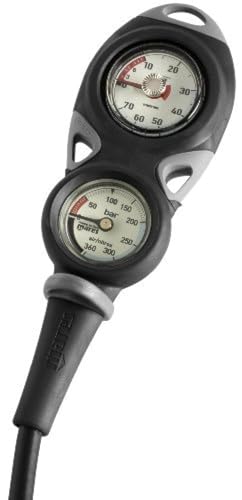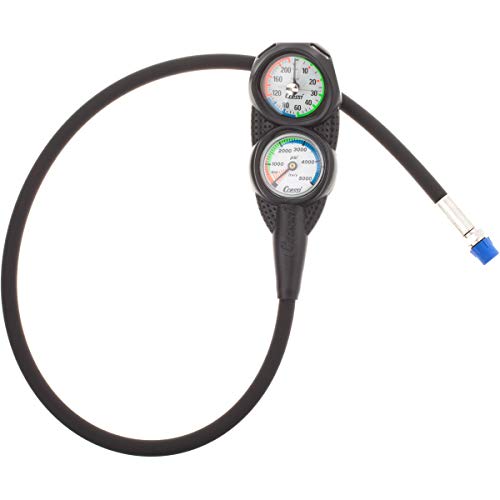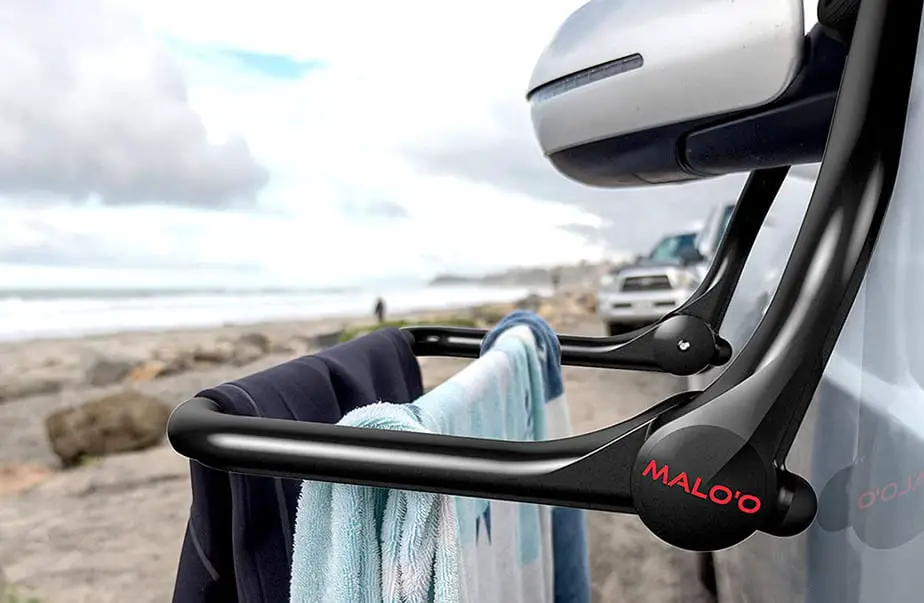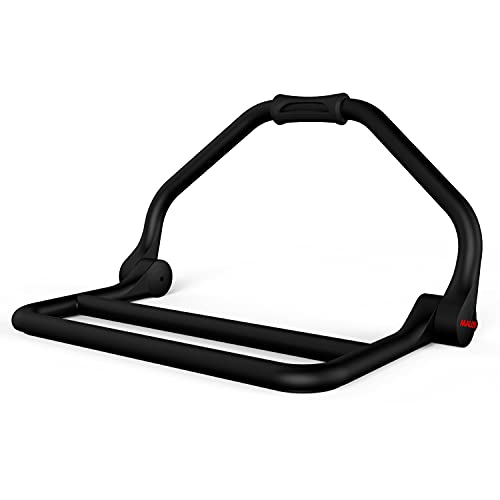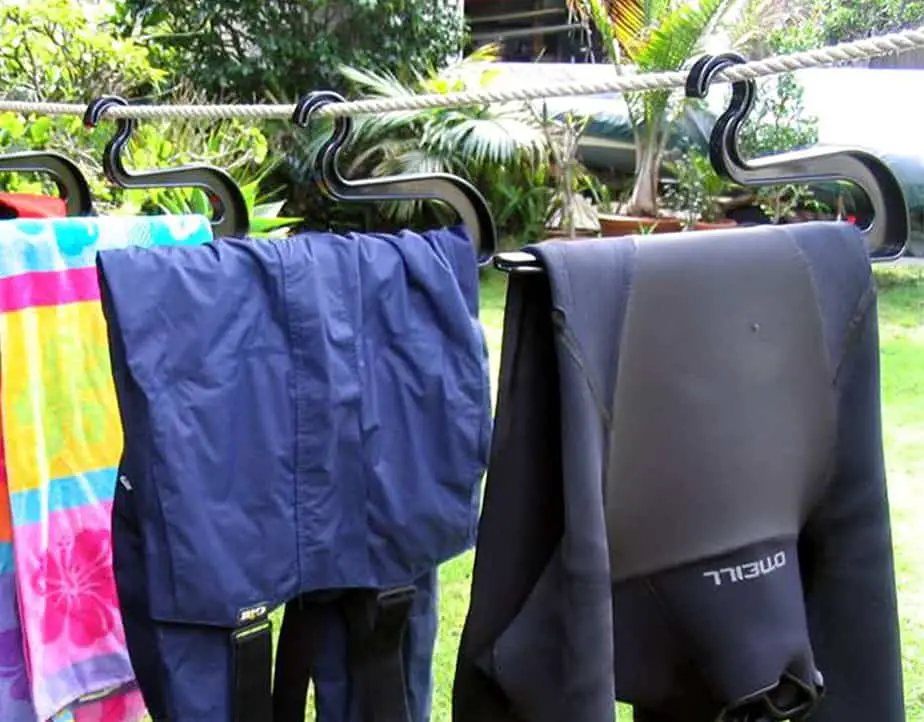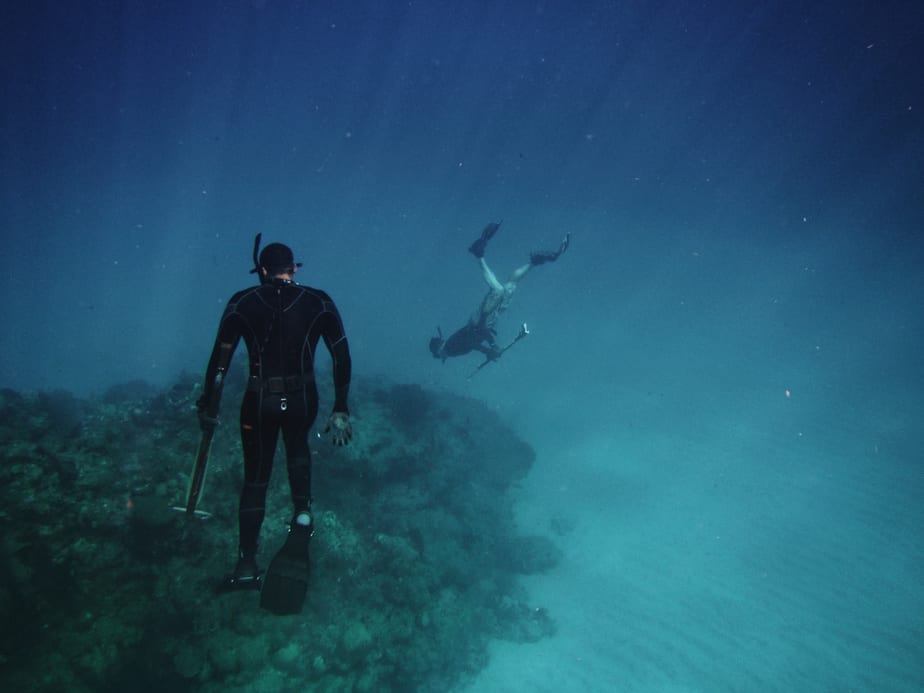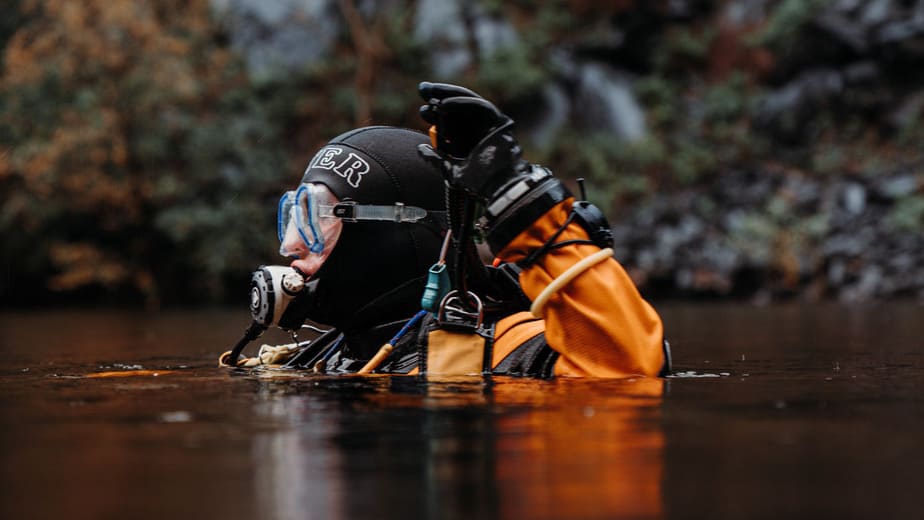Don’t underestimate how much heat loss occurs from your hands. Not wearing dive gloves while scuba diving or spearfishing is a big mistake that will decrease your bottom time. You may be hesitant about getting dive gloves because they will make you less dexterous. While true, the advantages they offer far outweigh any downsides.
No matter the temperature of the water you are diving in, you should wear dive gloves to insulate your hands and protect it from scratches. Especially for cold water diving, you will lose sensation in your hands in 10 minutes and run the risk of getting hypothermia. For wreck diving and spearfishing, the best dive gloves will protect you from sharp edges and provide extra grip.
With hundreds of models and dozens of brands on the market, finding the best dive gloves for you can be a daunting task. How thick should the gloves be? What materials and design should it have? What’s a good price? We answer all of these questions and more in this review and buying guide. Check out our recommendations below and peruse the buying guide to help you select the one that best suits your needs.
Our Top Picks:
Sale

Best Scuba Diving Gloves Recommendations
Cressi 2.5mm Neoprene Stretch Gloves
Cressi High Stretch 2.5mm, M , Black
- Five finger gloves made from single-lined soft, high-stretch Neoprene.
- The inside is covered in Metallite to make them easy to put on.
- The entire surface is covered with a non-slip finish for a sure grip in all situations.
Cressi is a top manufacturer of scuba gear, and their 2.5mm neoprene stretch gloves are nothing to scoff at. They come in three thicknesses from 2.5mm to 5.0mm, and they are covered in a non-slip grip finish for extra grip and protection. The 2.5mm is ideal for warm water activities such as snorkeling and recreational diving. The materials used are stretchy, and the pre-formed shape provides additional dexterity underwater. Water is kept out and your hands kept warm thanks to the solid-wrist design. You can’t go wrong with a pair of Cressi gloves.
- Material: Neoprene
- Thickness: 2.5mm / 3.5mm / 5.0mm
- Suitable for: Warm and temperate water diving
Notable Features:
- Non-slip grip surface.
- Three thickness options for various water temperatures.
- Soft Metallite lining for smooth donning and doffing.
- Pre-formed shape and stretchy neoprene.
ScubaPro Everflex 3mm Diving Gloves
Scubapro Everflex 3 mm Diving Glove (Large, Black)
- Made from extremely soft and flexible neoprene, the glove offers excellent warmth, comfort, and protection.
- The contoured shape improves finger dexterity, making it easier to operate your computer and take pictures.
- An ultra-smooth inside plush lining is warm and quick-drying, while the textured fingers and palm provide a good gripping surface.
The ScubaPro Everflex is easy to don and doff thanks to its flexibility despite not using a Velcro wrist or zipper. It offers great abrasion resistance with its reinforced fingers and palms that also provide superior grip. Built with comfort in mind, the Everflex uses stretchy neoprene that seals tightly and dries quickly. To prevent water intrusion, the Everflex uses blind-stitch construction for extra durability. This is a solid option for diving in mild to warm waters.
- Material: Neoprene
- Thickness: 3mm
- Suitable for: Warm to temperate water diving
Notable Features:
- Can be used for recreational or technical diving.
- Ideal for travel.
- Assembled with solvent-free glue.
- Single wrist seal insulates while minimizing water intrusion.
Neo-Sport Premium Neoprene Dive Gloves
If you want an all-around, reliable pair of gloves that can be used for diving, watersports, or general maintenance, then this five-finger wetsuit gloves from Neo-Sport is a solid option. These gloves come in 3mm and 5mm versions, and are designed to not only insulate, but also protect your hands in harsh environments. The velcro-elastic strap fastens the glove around your wetsuit to keep water out, but can also easily be removed when needed. This is a highly versatile glove that provides excellent bang-for-the-buck.
- Material: Neoprene
- Thickness: 3mm / 5mm
- Suitable for: Warm to temperate water diving, all water sports, gutter cleaning, pond and aquarium maintenance.
Notable Features:
- Sewn and glued seams offer extra waterproofing integrity.
- Extra-grip textured palm.
- Highly versatile, can be used for all-purposes.
- Unbeatable quality for the price.
Seavenger Abyss 1.5mm Dive Gloves
The Seavenger Abyss dive gloves are durable and lightweight, making them the optimal choice for warm water scuba diving and spearfishing. It is designed to maintain the wearer’s dexterity so that they can perform the precise movements needed for smooth diving and spearfishing. The shape will conform perfectly to your hands and provide much-needed protection while underwater. The velcro straps keep the gloves secured and water from seeping in. You can get the Seavenger Abyss in five colors and numerous sizes ranging from 2XS to 2XL so there’s a size for everyone.
- Material: Neoprene
- Thickness: 1.5mm
- Suitable for: Warm water diving and spearfishing
Notable Features:
- Reinforced with durable Amara leather.
- 5 color options and sizes from 2XS to 2XL.
- Ergonomic shape designed to fit the natural curvature of the hand.
Promate 3mm Kevlar Dive Gloves
The Promate 3mm kevlar dive gloves are the optimal choice for technical and commercial divers that will be handling rough and coarse objects. They have been reinforced with flexible and durable kevlar over the palm and fingers. These gloves have been pre-curved so that they can fit snug right off the bat. The velcro closure makes donning and doffing a breeze. Protect your hands from both the cold and underwater hazards with the Promate kevlar dive gloves.
- Material: Neoprene, kevlar
- Thickness: 3mm
- Suitable for: Warm to moderate water diving
Notable Features:
- Scratch and cut-resistant kevlar material on the finger and palm area.
- Flexible yet durable construction.
- Ideal for technical or commercial divers.
- Velcro wrist strap.
Mares Flexa Fit 5mm Dive Gloves
With its double-blind stitched and triple glued seams, the Mares Flexa Fit is built to last. These gloves are designed for harsh cold water conditions, and the ultra-stretch material provides comfort while making them easy to put on and take off. The rubber printed palm protects your hands from scratches and abrasions while providing additional grip.
What makes the Mares Flexa stand out is its pre-formed wrist shape and innovative cut. This ensures that there is a watertight seal that keeps your hands warm and dry.
- Material: Nylon, Neoprene rubber
- Thickness: 5mm
- Suitable for: Temperate and cold water diving
Notable Features:
- Pre-bent finger shape and innovative cut.
- Double-blind stitched and triple glued seams.
- Rubber printed palm increases grip.
- Ultra-stretchy material.
AquaLung 5mm Thermocline Kevlar Dive Gloves
For those planning on cold water diving, you need a thick and reliable pair of gloves. The AquaLung 5mm thermocline kevlar gloves fit that bill with its thick neoprene material. Furthermore, the 5” zipper design makes donning and doffing extremely straightforward. The zipper was designed to limit corrosion from exposure to saltwater.
Thanks to its pre-curved fingers, these gloves have been ergonomically designed to fit snugly on your hands out of the box to maintain dexterity and minimize fatigue. To minimize water intrusion, the seams have been blind-stitched and glued. The AquaLung 5mm gloves have been reinforced with ballistic strength synthetic fiber on the palm, fingertips, and even back of the gloves for superior abrasion resistance and enhanced grip. If you need a heavy-duty pair of gloves, then this a solid choice.
- Material: Neoprene
- Thickness: 5mm
- Suitable for: Temperate and cold water diving.
Notable Features:
- Large 5” zipper leaves a wide opening for easier donning and doffing.
- 2mm neoprene gusset blind-stitched and glued for minimal water exchange.
- YKK zipper is corrosion-resistant.
- Silicone printed palm provides extra grip.
D-Vein Lobster Gloves for Diving and Spearfishing
Lobster Gloves for Diving Kevlar Spearfishing Dive Glove Puncture Resistant (X-Large)
- MADE WITH KEVLAR FIBER MATERIAL: Unlike nylon, leather and high-performance polyethylene gloves, which are often used to make sport diving gloves...
- ALL AROUND PROTECTION: Our D-Vein Gloves for Lobstering are designed to keep your hands safe throughout the lobster diving experience. Aside from the...
- EASY TO USE: Many scuba glove products are difficult to use due to their stiff and bulky composition. Gloves that aren’t pliable for a firm grasp...
Though these gloves were designed with lobstering in mind, they are capable of so much more. You can use it for basically any water sports activity you want, including diving, spearfishing, snorkeling, and so on. Because of its lightweight design and flexibility, it is highly versatile.
Furthermore, the D-Vein gloves are made of kevlar with a non-slip grip on the palms as well as a rubber coating on the back side for added protection. This pair of gloves manages to combine resilience with flexibility, so you don’t have to worry about your catch of the day cutting you or wiggling away from your hands.
As soon as you try on the D-Vein gloves, you will understand how pliable and soft these gloves are on the inside. It allows you to easily manipulate your fingers with almost no loss of dexterity, unlike many bulky, awkward gloves on the market. Taking care of the D-vein gloves is very straightforward. You can just throw it in the washing machine and leave them out to air dry overnight. These gloves are so convenient, versatile, and available at an affordable price.
- Material: Kevlar
- Thickness: 1.5mm
- Suitable for: Warm water diving, snorkeling, spearfishing
Notable Features:
- Perfect for all water sports and activities.
- Flexible fingers with a firm non-slip grip.
- Washing machine friendly.
- Backside is coated in rubber armor for extra protection.
ScubaPro Tropic 1.5mm Dive Gloves
SCUBAPRO Tropic 1.5mm Diving Glove, Unisex, 2XL, Graphite
- Protect your hands from cold waters and sharp barnacles with this pair of Tropic diving gloves, featuring a 1.5mm neoprene back for comfort and...
- Great for diving and snorkeling, the glove's Amara faux leather fabric layer on the palm protects against infection-prone cuts when grasping...
- Other features include reinforced fingertips for increased durability and a non-slip grip and an adjustable Velcro wrist seal to ensure a snug fit.
Next we have a popular warm water diving glove by ScubaPro; the Tropic 1.5mm dive gloves are as durable as they are lightweight. Made from Neoprene X-foam, this glove is petroleum-free and made with responsible materials that protects divers and the oceans. Another advantage of this neoprene is that it provides added comfort and warmth.
In order to protect against infection-prone cuts, the Tropic is reinforced with an Amara palm and fingertips that are often caused by grasping barnacle-encrusted ladders or edges in tropical waters. These gloves come in a variety of aesthetic patterns and colors that will be sure to catch the eye.
- Material: Amara fabric, limestone neoprene
- Thickness: 1.5mm
- Suitable for: Warm water diving
Notable Features:
- Amara fabric palm that is resistant to punctures and is soft when dry.
- Reinforced palm and fingertips for added durability and a non-slip grip.
- Velcro wrist seal for a snug fit.
XS Scuba 5mm Dry Five Pyrostretch Gloves
The XS Scuba 5mm Pyrostretch gloves are a pair of true dry gloves designed for cold water diving. To ensure no water seeps in, the seams have been blind-stitched, glued, and liquid-taped so that they are extra durable. Your hands will not only stay warm, but completely dry during the dive.
Furthermore, the Pyrostretch neoprene is very flexible so it won’t hinder dexterity too much while worn. The solid wrist design forms a tight seal to decrease the chances of water entering the gloves. Lastly, the palm is textured to provide a non-slip grip and add an extra bit of protection for your palm.
- Material: Pyrostretch neoprene
- Thickness: 5mm
- Suitable for: Temperate and cold water diving.
Notable Features:
- True dry gloves designed for cold water diving.
- Highly stretchable neoprene material provides a custom-like fit.
- Seams have been blind-stitched, glued, and liquid-taped.
- Twin-cuff design keeps water from entering through the wrist area.
Dive Gloves for Scuba and Spearfishing Buying Guide
Gloves may not be a high priority for you if you are a warm water diving. If you’re a cold water diver, then gloves are one of the most important items to prevent heat loss from your extremities. So don’t haphazardly purchase this essential diving accessory because it can make a big difference when you are out on a dive. In this section, we will go over the major factors to consider when shopping for a pair of dive gloves.
If you learn nothing else from this article, then at least know that the four most important considerations for dive gloves are:
- Do they insulate your hands?
- Are they comfortable?
- Can you still perform the necessary actions with a glove on?
- Are the gloves durable enough for your diving style?
Now, let’s get into the nitty-gritty.
Materials
Do you like to dive with bare hands so that you can feel your equipment and have greater dexterity? Under 12°C you will lose sensation in your hands after 10 minutes, so why bother? Keep your hands warm while improving the suit’s seal on your wrist by wearing dive gloves. Gloves provide another advantage, which is that they offer a layer of protection to grab onto something if you are caught in a strong current.
The materials the dive glove is made from each have their pros and cons. You will have to find a good compromise between freedom of movement, thermal protection, and comfort. Dive gloves have thicknesses between 1-7mm thick and they should fit you like a second-skin. Even if the gloves feel tight on land, you won’t notice anything underwater since the neoprene will compress under pressure.
There are basically two types of materials to consider when looking for a pair of dive gloves.
Neoprene Diving Gloves
For the most insulation, use neoprene gloves.
They can be found in a thickness of 0.5-7mm, and neoprene gloves provide plenty of versatility. For example, you can find neoprene gloves reinforced with Amara or spratex, both of which improve sturdiness and grip on the palm as well as between the fingers. How sturdy they are depends on how thick they are. Neoprene gloves are optimal for diving and snorkeling, and the thickest ones are pre-shaped for superior grip and easier donning.
Textile Diving Gloves
The key features of textile diving gloves are their sturdiness and how easy they are to don.
Textile gloves are a great choice for protecting your hands when spearfishing, and they can also be used for scuba diving. They are often made of 1-2mm thick fabric. Some have an “Amara” textile on the fingers and palm to provide a better sense of touch. Others are coated with latex on the palm to resist wear and tear and cuts.
This type of glove does not provide the greatest thermal protection, however it compensates by offering unparalleled freedom of movement and a greater sense of touch. It can be used for diving at temperatures down to 15°C.
Warmth
One important distinction to keep in mind is that the vast majority of dive gloves are designed to keep your hands warm, but NOT dry. In fact, the way they do so is by trapping the water that enters and insulating the heat your body generates to warm the water within your gloves. Don’t be alarmed when you get to the surface and a flood of trapped water finally exits your gloves.
Most dive gloves are made of neoprene. Your wetsuit and dive hood are probably made of it as well. Neoprene is measured in millimetres, and the thicker it is the more warmth it will provide. If you dive exclusively in warm water and you just want some protection against the elements, then a thin pair of dive gloves are sufficient for your needs. Anything more than that and you may need a thick pair of neoprene gloves to keep you warm.
Fasteners
The sealing system affects how much insulation the gloves can provide. There are several types of fasteners, and each one provides different sealing qualities. The type of fastener that your gloves have will affect how much water enters as well as how easy it is to don and doff.
The most common type of fastener is the zip fastener. Most zips have a large puller to help you operate the zipper on the other glove once you have the first glove on.
Next, velcro straps are another type of fastener that makes donning and doffing very straightforward as well.
However, the most popular type of fastening system is simply a long, flexible wrist with no velcro or zipper. The glove’s flexibility provides a kind of seal around the wrist as you twist and turn it. The downside of this design is that it will lose flexibility over time, but it works well enough for the most part. This option is the most affordable which contributes to its popularity.
Gloves vs. Mitts
Another consideration to keep in mind is the difference between gloves and mitts. The more skin-to-skin contact you have, the warmer you’ll feel. Since gloves do not allow your fingers to have direct contact with each other, they are less warm than mitts.
That is the reason why five fingered gloves are not as warm as 3-fingered mitts, which are not as warm as mitts. Mitts have a thumb sleeve and a larger sleeve for all of your fingers. In other words, gloves are not as warm as mitts, however the vast majority of divers wear five-fingered dive gloves.
Additional factors that can provide extra warmth are if the gloves provide a velcro strap around the wrist to provide a tighter seal and limit the amount of water transfer in and out of the gloves. Or if the gloves have supplemental materials (e.g. titanium), as well as the number of seams. The fewer seams there are, the less places for water to enter from.
To address this, some gloves offer a strapless fit that keeps you warmer. However, this makes it very difficult to put on, especially the second glove since you will lose dexterity after the first glove is on.
Water Temperature
You need to select the appropriate glove and thickness for the kind of water you will be diving in. Here is a good rule of thumb to follow:
- Warm Water (>25°C) – Use gloves with 0.5-2.0mm of neoprene.
- Temperate Water (16-24°C) – Use gloves with 2-5mm of neoprene.
- Cold Water (10-18°C) – Use gloves with 5-7mm of neoprene.
Finding the Perfect Fit
No matter how warm your gloves are, you won’t be wearing them for very long if they are uncomfortable. The entire time you are diving, you will be thinking about how much of a hindrance they are. If the gloves feel off when you are on land, then any issues will only be exacerbated once you are underwater.
For example, if your gloves are on the small side, then the seams will be stretched and worn out much faster than usual. Very quickly, you will notice that cold water is entering from these stressed seams. As your dive progresses, you will notice your hand get colder and colder, defeating the purpose of the gloves.
Conversely, if your gloves are too large, then the water will not get trapped between your hand and glove. If the water is not trapped, your body cannot heat it up, and you will have cold hands for the entire dive as well.
Dexterity
Divers have to manage many pieces of gear underwater. They must clear water from their masks, adjust various straps, manipulate their gauges, and adjust the air levels in their BCDs just to list a few.
How quickly and efficiently a diver can accomplish this depends on how much dexterity they have at depth with gloves on. Since five-fingered gloves let you move each finger independently, they offer the greatest amount of dexterity. They let you take advantage of each finger to grip or rotate, and are the easiest to write with on an underwater slate.
The next level of dexterity provided is with three-finger mitts. This is the middle-ground option which provides a good balance of dexterity and warmth. Just having the index finger and thumb uncovered lets divers adjust their gear easily, allows for simple manipulation, and even lets one write using their slate’s pencil. Hand-signaling also becomes possible, such as the basic “OK” sign.
Lastly, mitts provided the least amount of dexterity which can make it difficult or impossible to manipulate some of your gear. It also hinders communication because hand signals are out of the question. The upside is that you will be very warm, however the inability to write or signal with ease are some serious downsides.
Durability
As a material, neoprene is stretchy but does not provide much grip or strength. To address this, dive glove manufacturers have to supplement their neoprene gloves with strength-increasing materials, such as titanium or Kevlar, often on the palm side of their mitts or gloves.
By strengthening the palm area, the glove’s life-span is greatly extended. Sharp edges on gear and accidental contact with wrecks, debris, or other underwater hazards would otherwise tear holes in the palm and fingers of your glove.
These non-neoprene materials provide more than just extra durability; they also increase your dexterity by providing extra grip. Anyone who has struggled to manipulate their scuba gear or write with a pencil while underwater will appreciate any attempt to increase slip-resistance of their gloves.
Kevlar gloves are used frequently by divers that are diving to collect abalone, rock lobster (crays), or scallops.
What Kind of Diver Are You?
In order to determine which gloves are the best option for you, you need to ask yourself: what kind of activities do I plan on doing? If you are just a casual or recreational diver, then basic gloves will work. You don’t need to worry about having extra features, it just needs to keep your hands warm.
If you need a heavy-duty pair of gloves for underwater work, fish farm repairs, etc., then you need to look for some reinforced gloves. If you do a lot of night diving, wreck diving, cave diving, and other such activities where it is really easy for scratches to occur on your hands, then look for gloves that have been reinforced with Amara, latex, or other resistant materials.
Divers who need to use their hands to perform fine movements need thin gloves which provide greater freedom of movement and sensitivity. If you need to take photos in cold waters, then you need to find a pair of gloves that provide a good balance of dexterity and insulation without being too thick.
Brands and Budget
There are many reputable manufacturers that produce quality scuba diving gear. Just to name a few, you may have heard of Mares, Neosport, Cressi, Aqualung, and ScubaPro. Their gear is not only reliable, but they are also quite affordable for the most part. There are more expensive brands, however you don’t need to spend a small fortune to get decent gloves (unless you have very specific needs).
On the other extreme, you will find many models for less than $10 USD. These are generally low-quality knock-offs that aren’t effective nor long-lasting. You will find that they either don’t work as advertised or you will need to replace them frequently. Better to spend a bit more money upfront for a pair of scuba gloves from any of the brands listed above and have it last for years.
Maintenance
After you are finished with a dive, particularly if you were in saltwater, you must perform the necessary precautions to ensure they last a long time. Leaving salt in the gloves will degrade the gloves and irritate your hands on the next dive. All diving equipment needs proper maintenance, and the gloves are no exception!
Cleaning your gloves is very similar to how you would clean your other scuba equipment. Rinse them off with fresh water, making sure no dirt or salt remains. Rinse both the inside and outside of the gloves. You can use some mild soap, wetsuit wash, or shampoo to aid you.
After you are finished rinsing, hang the gloves upside down to dry in a well-ventilated area in the shade. Do NOT leave them in direct sunlight; the UV rays will degrade the material and make it brittle. Make sure the gloves are dry before storing. If you will be leaving it in storage for a long time, make extra sure that it is dry to prevent mold growth. Also do not put anything heavy on top of the gloves.
Closing Thoughts
Whether you are diving in warm, mild, or cold water, dive gloves can provide some benefits for you in the form of protection and insulation. If you are worried about losing dexterity in your fingers, there are thin gloves that are only 1-3mm thick, as well as 3-finger mitts that let you use your index finger and thumb. These designs make it easier to manipulate your scuba gear and perform hand signals while protecting you from the cold.
Diving is already an inherently risky activity, and you want to take as many necessary precautions to ensure each dive goes smoothly. To that end, you should be covering up your body as much as possible so that there aren’t any exposed or vulnerable areas that can get injured. If your hands get too cold or they get scratched up, then that marks the end of your dive.
By purchasing any of the gloves we recommended in the list above, or buying from reputable brands from Mares, ScubaPro, Aqualung, Cressi, etc., then you can be sure you are getting the best dive gloves on the market. Avoid buying cheap knock-offs just to save a buck; they will break easily and you will have to spend more money to replace it. Buy a good one to start with, take good care of it, and it will last for years.
Lastly, make sure that the gloves you purchase are thick enough for the water temperature you will be diving in, and that it can help you accomplish your tasks. Look for gloves that have been reinforced in the palm and finger area to provide extra grip and protection against sharp edges. Determine whether gloves or mitts are the better option, and find one that fits your price range.
By following the advice provided in this article, you will be sure to find the best dive gloves for scuba diving and spearfishing at an affordable price. Then you will be well on your way to a longer bottom time and overall better scuba or spearfishing experience.B

